Quick Summary:
- A restaurant website is essential for growth and customer service.
- Careful planning and mobile-first design are crucial.
- Feature clear menus, online ordering, and reservations.
- Optimize for search engines and update content regularly.
Table of Contents
- Why Your Restaurant Needs a Website (Like, Yesterday)
- Attracting New Customers: Your Digital Billboard
- Serving Your Existing Customers Better: Building Loyalty
- The Bottom Line: More Customers, More Revenue
- Phase 1: Planning Your Restaurant Website – The Recipe for Success
- 1. Define Your Goals: What Do You Want to Achieve?
- 2. Know Your Target Audience: Who Are You Trying to Reach?
- 3. Content Strategy: What Will You Say and How Will You Say It?
- 4. Functionality: What Features Do You Need?
- 5. Keyword Research: What Are People Searching For?
- Phase 2: Choosing the Right Platform – Your Restaurant Website Foundation
- 1. Website Builders: User-Friendly Drag-and-Drop
- 2. Content Management Systems (CMS): Flexibility and Control
- Why wordpress is Often the Best Choice:
- 3. Custom Development: Bespoke Solutions
- Choosing the Right Domain Name: Your Online Address
- Phase 3: Designing Your Restaurant Website – Creating a Visual Feast
- 1. Mobile-First Design: Prioritizing the Mobile Experience
- 2. Visual Appeal: Creating a Mouthwatering Experience
- 3. User-Friendly Navigation: Making It Easy to Find What They Need
- 4. Branding: Reinforcing Your Restaurant’s Identity
- Phase 4: Content Creation – Telling Your Restaurant’s Story
- 1. Menu: The Star of the Show
- 2. About Us: Connecting with Your Customers
- 3. Location & Contact: Making It Easy to Reach You
- 4. Blog/News: Keeping Your Website Fresh
- Phase 5: SEO Optimization – Making Your Restaurant Discoverable
- 1. Keyword Research: Targeting the Right Terms
- 2. On-Page Optimization: Optimizing Your Website’s Content
- 3. Off-Page Optimization: Building Your Website’s Authority
- 4. Technical SEO: Ensuring Your Website is Search Engine Friendly
- Phase 6: Testing and Launching Your Website – Ready to Serve!
- 1. Cross-Browser and Cross-Device Testing: Ensuring Compatibility
- 2. Functionality Testing: Verifying All Features Work
- 3. Content Review: Ensuring Accuracy and Quality
- 4. Performance Testing: Optimizing for Speed
- 5. Launching Your Website: Going Live!
- Phase 7: Maintaining and Updating Your Website – Keeping It Fresh and Engaging
- 1. Content Updates: Keeping It Relevant
- 2. SEO Monitoring and Optimization: Staying Ahead of the Curve
- 3. Security Updates: Protecting Your Website and Your Customers
- 4. Performance Monitoring: Ensuring Speed and Reliability
- 5. Gather Customer Feedback: Improving the User Experience
- Qrolic Technologies: Your Partner in Digital Success
- How Qrolic Technologies Can Help:
- Conclusion: Start Building Your Restaurant’s Digital Future Today
Why Your Restaurant Needs a Website (Like, Yesterday)

Running a restaurant is hard work. You’re juggling ingredients, staff, and hungry customers. So, why add another plate to spin by creating a website? Because in today’s digital world, a restaurant website is no longer optional; it’s essential. Think of it as your 24/7 virtual greeter, attracting new customers and keeping loyal ones coming back for more.
Attracting New Customers: Your Digital Billboard
- Increased Visibility: People are searching online for restaurants near them right now. If you don’t have a website, you’re invisible. A well-optimized website makes you discoverable in search results.
- First Impressions Matter: Your website is often the first interaction potential customers have with your restaurant. It’s your chance to showcase your ambiance, cuisine, and personality. A professional website screams “quality and care.”
- Local SEO Domination: Compete effectively in local searches. A website optimized for “best pizza in [your city]” can bring in a steady stream of new customers.
Serving Your Existing Customers Better: Building Loyalty
- Easy Access to Information: Customers want to know your hours, location, menu, and contact information. A website provides this instantly, saving them time and frustration.
- Online Ordering Convenience: Offer takeout and delivery directly through your website. This provides a seamless experience, boosting orders and revenue. No more hefty third-party fees eating into your profits.
- Reservations Made Easy: Integrate online reservation systems. Customers can book tables anytime, anywhere, without having to call.
- Promote Specials and Events: Announce happy hour deals, seasonal menus, and special events. Keep your customers informed and excited about what’s happening at your restaurant.
- Build a Community: A blog or news section allows you to share stories, recipes, and insights, building a stronger connection with your audience.
The Bottom Line: More Customers, More Revenue
A restaurant website isn’t just a digital brochure; it’s a powerful marketing tool. It’s an investment that pays off in increased visibility, customer loyalty, and ultimately, higher revenue. Without it, you’re losing customers to competitors who have embraced the digital age.
Phase 1: Planning Your Restaurant Website – The Recipe for Success
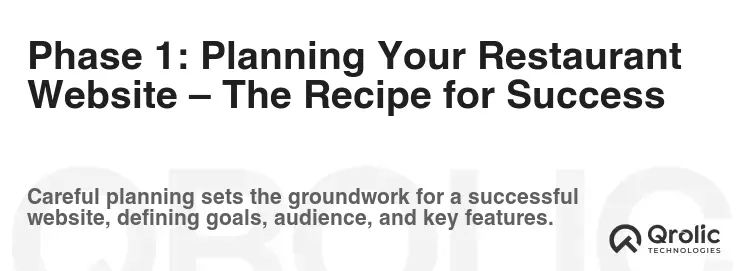
Before you even think about choosing a template or writing code, you need a solid plan. This is where you define your goals, understand your target audience, and create a blueprint for your website’s content and functionality.
1. Define Your Goals: What Do You Want to Achieve?
Be specific. Don’t just say, “I want more customers.” Break it down:
- Increase online orders by X% in the next 6 months.
- Generate Y new reservations per week.
- Grow email list by Z subscribers per month.
- Improve customer engagement on social media.
- Reduce reliance on third-party delivery apps.
These specific goals will guide your website’s design and content.
2. Know Your Target Audience: Who Are You Trying to Reach?
Understanding your ideal customer is crucial.
- Demographics: Age, location, income, education.
- Psychographics: Interests, values, lifestyle, pain points.
- Dining Habits: Frequency of dining out, preferred cuisine, budget.
- Online Behavior: How they search for restaurants, what websites they visit.
Create a detailed customer persona. For example:
- Name: Sarah
- Age: 30
- Occupation: Marketing Manager
- Location: Downtown
- Interests: Trying new restaurants, healthy eating, social gatherings
- Online Behavior: Uses Google Maps to find restaurants, reads online reviews, orders takeout through apps.
Knowing Sarah will help you tailor your website’s design, content, and messaging to appeal to her.
3. Content Strategy: What Will You Say and How Will You Say It?
This is where you map out the key pages and content for your website.
- Homepage: The first impression. Include a compelling headline, stunning visuals, and clear call-to-actions (e.g., “View Menu,” “Order Online,” “Make a Reservation”).
- Menu: Your most important page. Display your menu clearly and attractively, with descriptions and pricing. Consider using high-quality photos.
- About Us: Tell your story. Share your restaurant’s history, mission, and values. Introduce your team and highlight what makes your restaurant unique.
- Location & Contact: Provide your address, phone number, email address, and hours of operation. Embed a Google Maps to make it easy to find you.
- Online Ordering: Integrate a secure and user-friendly online ordering system.
- Reservations: Implement an online reservation system that integrates with your seating chart.
- Gallery: Showcase your restaurant’s ambiance and food with high-quality photos and videos.
- Blog/News: Share restaurant news, events, recipes, and behind-the-scenes stories. This keeps your website fresh and engaging and improves SEO.
- Specials & Promotions: Highlight current deals, happy hour specials, and limited-time offers.
- Events Calendar: Promote upcoming events like live music, wine tastings, or holiday celebrations.
4. Functionality: What Features Do You Need?
Consider these essential features:
- Responsive Design: Your website must look good and function perfectly on all devices (desktops, tablets, and smartphones).
- Online Ordering System: Seamless integration for takeout and delivery orders.
- Online Reservation System: Easy booking for tables and private events.
- Payment Gateway: Secure online payment processing for orders and reservations.
- Email Marketing Integration: Capture email addresses and send newsletters and promotions.
- Social Media Integration: Connect your website to your social media accounts.
- Analytics Tracking: Use Google Analytics to track website traffic and user behavior.
5. Keyword Research: What Are People Searching For?
Understanding the keywords your target audience uses to search for restaurants is vital for SEO. Use tools like Google Keyword Planner, SEMrush, or Ahrefs to identify relevant keywords.
- Location-Based Keywords: “Restaurants near me,” “Italian restaurant [city],” “best burger [neighborhood].”
- Cuisine-Specific Keywords: “Mexican food delivery,” “vegan restaurant,” “seafood restaurant.”
- Menu Item Keywords: “Best pizza,” “steakhouse,” “sushi restaurant.”
- Service-Based Keywords: “Catering services,” “private dining room,” “outdoor seating.”
Incorporate these keywords naturally throughout your website’s content.
Phase 2: Choosing the Right Platform – Your Restaurant Website Foundation
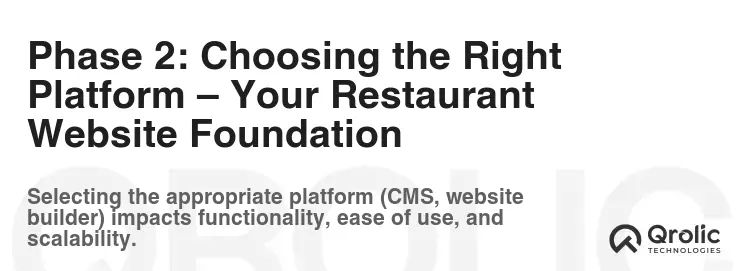
Now that you have a plan, it’s time to choose the platform for building your website. There are several options, each with its own pros and cons.
1. Website Builders: User-Friendly Drag-and-Drop
- Examples: Wix, Squarespace, Weebly
- Pros: Easy to use, no coding required, pre-designed templates, affordable plans.
- Cons: Limited customization, less control over SEO, may not be suitable for complex websites.
Who are they best for?
Small restaurants with simple needs, limited technical skills, and a tight budget.
Key Features to Look For:
- Restaurant-specific templates
- Online ordering integration
- Reservation system integration
- Menu display options
- Mobile-friendly design
2. Content Management Systems (CMS): Flexibility and Control
- Examples: WordPress, Joomla, Drupal
- Pros: Highly customizable, powerful SEO features, extensive plugins and themes, suitable for complex websites.
- Cons: Requires some technical knowledge, steeper learning curve, more maintenance required.
Who are they best for?
Restaurants that need a highly customizable website with advanced features, strong SEO, and the ability to scale.
Key Features to Look For:
- SEO-friendly design
- Plugin support for online ordering, reservations, and other functionalities
- Responsive themes
- Content management capabilities
Why wordpress is Often the Best Choice:
WordPress is the most popular CMS in the world, powering over 40% of all websites. It offers a winning combination of flexibility, power, and ease of use.
- Huge Community & Support: Countless tutorials, forums, and developers available to help you.
- Tons of Themes & Plugins: Find the perfect design and add any functionality you need.
- SEO Powerhouse: Optimized for search engines right out of the box.
3. Custom Development: Bespoke Solutions
- Pros: Complete control over design and functionality, tailored to your specific needs.
- Cons: Most expensive option, requires hiring a developer, time-consuming.
Who are they best for?
Large restaurant chains or restaurants with very specific requirements that cannot be met by website builders or CMS platforms.
Key Considerations:
- Choose a reputable development agency with experience in restaurant website design.
- Clearly define your requirements and budget.
- Ensure the website is SEO-friendly and mobile-responsive.
Choosing the Right Domain Name: Your Online Address
Your domain name is your website’s address on the internet. It should be:
- Easy to Remember: Simple and memorable.
- Relevant to Your Restaurant: Include your restaurant name or a keyword related to your cuisine.
- .com is Preferred: It’s the most common and recognizable extension.
- Available: Check if the domain name is available before you get too attached to it.
Phase 3: Designing Your Restaurant Website – Creating a Visual Feast
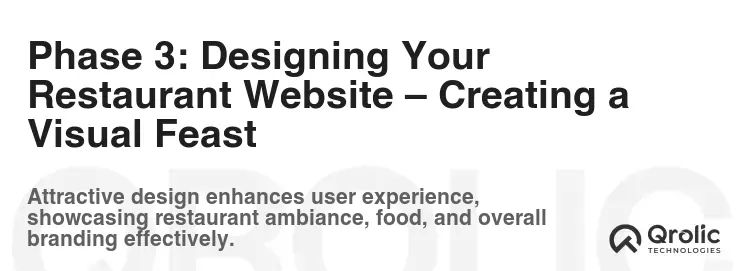
Your website’s design is crucial for attracting and retaining customers. It should be visually appealing, easy to navigate, and reflect your restaurant’s brand.
1. Mobile-First Design: Prioritizing the Mobile Experience
More people are browsing the internet on their smartphones than on desktops. Therefore, your website must be designed with mobile users in mind.
- Responsive Design: Ensures your website adapts seamlessly to different screen sizes.
- Fast Loading Speed: Mobile users are impatient. Optimize your website for speed to avoid losing visitors.
- Easy Navigation: Use a clear and concise menu that is easy to access on mobile devices.
- Touch-Friendly Design: Use large buttons and links that are easy to tap on a touchscreen.
2. Visual Appeal: Creating a Mouthwatering Experience
- High-Quality Photography: Use professional photos of your food, restaurant interior, and staff. Avoid using stock photos.
- Appealing Color Palette: Choose colors that reflect your restaurant’s brand and create a welcoming atmosphere.
- Clean and Modern Layout: Avoid clutter and use plenty of white space to make your website easy to read.
- Engaging Videos: Use videos to showcase your restaurant’s ambiance, food preparation, or customer testimonials.
3. User-Friendly Navigation: Making It Easy to Find What They Need
- Clear and Concise Menu: Use a simple and intuitive menu structure.
- Prominent Call-to-Actions: Make it easy for visitors to order online, make a reservation, or contact you.
- Easy-to-Find Contact Information: Display your address, phone number, and email address prominently.
- Search Functionality: Allow visitors to search for specific menu items or information on your website.
4. Branding: Reinforcing Your Restaurant’s Identity
- Consistent Use of Logo and Colors: Use your logo and color palette consistently throughout your website.
- Unique Tone of Voice: Use language that reflects your restaurant’s personality and brand.
- Showcase Your Restaurant’s Story: Share your restaurant’s history, mission, and values.
Phase 4: Content Creation – Telling Your Restaurant’s Story
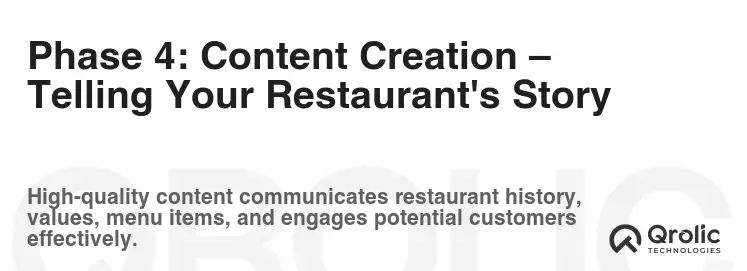
High-quality content is essential for attracting and engaging visitors. It should be informative, well-written, and optimized for search engines.
1. Menu: The Star of the Show
- Accurate and Up-to-Date: Ensure your menu is accurate and reflects your current offerings.
- Detailed Descriptions: Provide detailed descriptions of each dish, including ingredients and preparation methods.
- Pricing: Clearly display the price of each menu item.
- High-Quality Photos: Use mouthwatering photos of your most popular dishes.
- Downloadable PDF: Offer a downloadable PDF version of your menu for easy access.
- Highlight Dietary Options: Clearly indicate vegetarian, vegan, gluten-free, and other dietary options.
2. About Us: Connecting with Your Customers
- Tell Your Story: Share your restaurant’s history, mission, and values.
- Introduce Your Team: Highlight the people behind your restaurant, including chefs, managers, and staff.
- Showcase Your Restaurant’s Unique Features: Emphasize what makes your restaurant special, such as its ambiance, cuisine, or service.
- Include Testimonials: Feature positive reviews from satisfied customers.
3. Location & Contact: Making It Easy to Reach You
- Accurate Address and Phone Number: Display your address and phone number prominently.
- Google Maps Integration: Embed a Google Maps to make it easy for visitors to find your restaurant.
- Hours of Operation: Clearly display your hours of operation.
- Email Address: Provide an email address for inquiries and feedback.
- Contact Form: Include a contact form for visitors to send you messages.
4. Blog/News: Keeping Your Website Fresh
- Share Restaurant News and Events: Announce new menu items, special events, and promotions.
- Offer Recipes and Cooking Tips: Share your culinary expertise with your audience.
- Behind-the-Scenes Stories: Give visitors a glimpse into the inner workings of your restaurant.
- Guest Posts: Invite local food bloggers or chefs to contribute content to your blog.
Phase 5: SEO Optimization – Making Your Restaurant Discoverable

Search engine optimization (SEO) is crucial for driving traffic to your website. By optimizing your website for search engines, you can improve your ranking in search results and attract more potential customers.
1. Keyword Research: Targeting the Right Terms
- Identify Relevant Keywords: Use keyword research tools to identify the keywords your target audience uses to search for restaurants.
- Location-Based Keywords: Target keywords that include your city or neighborhood.
- Cuisine-Specific Keywords: Target keywords related to your cuisine.
- Menu Item Keywords: Target keywords related to your most popular menu items.
2. On-Page Optimization: Optimizing Your Website’s Content
- Use Keywords Naturally: Incorporate your target keywords naturally throughout your website’s content, including page titles, headings, and body text.
- Optimize Page Titles and Meta Descriptions: Write compelling page titles and meta descriptions that accurately describe the content of each page and encourage users to click through from search results.
- Use Header Tags (H1-H6): Use header tags to structure your content and highlight important keywords.
- Optimize Images: Use descriptive alt tags for your images and compress them to improve page loading speed.
- Internal Linking: Link to other relevant pages on your website to improve navigation and SEO.
3. Off-Page Optimization: Building Your Website’s Authority
- Build High-Quality Backlinks: Earn backlinks from other reputable websites, such as local directories, food blogs, and news websites.
- Local Citations: List your restaurant in online directories, such as Yelp, Google My Business, and TripAdvisor.
- Social Media Marketing: Promote your website and content on social media to drive traffic and engagement.
- Online Reviews: Encourage customers to leave positive reviews on Yelp, Google My Business, and other review sites.
4. Technical SEO: Ensuring Your Website is Search Engine Friendly
- Mobile-Friendly Design: Ensure your website is mobile-friendly and responsive.
- Fast Loading Speed: Optimize your website for speed to improve user experience and SEO.
- Sitemap Submission: Submit a sitemap to Google to help them crawl and index your website.
- Robots.txt File: Use a robots.txt file to control which pages search engines can crawl.
- SSL Certificate: Install an SSL certificate to secure your website and protect your visitors’ data.
Phase 6: Testing and Launching Your Website – Ready to Serve!
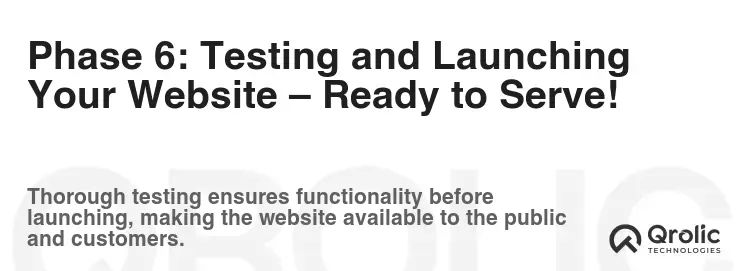
Before you launch your website, it’s crucial to test it thoroughly to ensure everything is working correctly.
1. Cross-Browser and Cross-Device Testing: Ensuring Compatibility
- Test on Different Browsers: Test your website on different browsers, such as Chrome, Firefox, Safari, and Edge, to ensure it looks and functions correctly on all of them.
- Test on Different Devices: Test your website on different devices, such as desktops, laptops, tablets, and smartphones, to ensure it is responsive and mobile-friendly.
2. Functionality Testing: Verifying All Features Work
- Test Online Ordering: Place a test order to ensure the online ordering system is working correctly.
- Test Reservations: Make a test reservation to ensure the reservation system is working correctly.
- Test Contact Form: Submit a test message through the contact form to ensure it is working correctly.
- Test All Links: Click on all the links on your website to ensure they are working correctly.
3. Content Review: Ensuring Accuracy and Quality
- Proofread All Content: Carefully proofread all the content on your website to ensure there are no typos or grammatical errors.
- Verify Accuracy: Ensure all the information on your website, such as your address, phone number, hours of operation, and menu items, is accurate.
- Check Image Quality: Ensure all the images on your website are high-quality and optimized for the web.
4. Performance Testing: Optimizing for Speed
- Test Page Loading Speed: Use a website speed testing tool to check your website’s loading speed.
- Optimize Images: Compress your images to improve page loading speed.
- Enable Browser Caching: Enable browser caching to improve website performance.
- Use a Content Delivery Network (CDN): Use a CDN to distribute your website’s content across multiple servers to improve loading speed for users around the world.
5. Launching Your Website: Going Live!
- Choose a Launch Date: Choose a launch date that makes sense for your business.
- Promote Your Website: Announce the launch of your website on social media, in your email newsletter, and in your restaurant.
- Monitor Your Website: Monitor your website’s performance and traffic after launch to identify any issues and make improvements.
Phase 7: Maintaining and Updating Your Website – Keeping It Fresh and Engaging
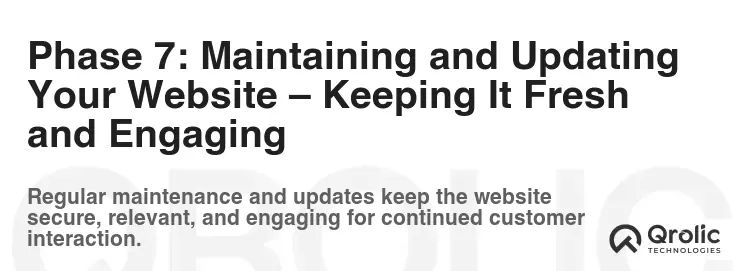
Your website is not a “set it and forget it” project. It requires ongoing maintenance and updates to keep it fresh, engaging, and optimized for search engines.
1. Content Updates: Keeping It Relevant
- Regularly Update Your Menu: Keep your menu up-to-date with your latest offerings and pricing.
- Add New Blog Posts: Publish new blog posts regularly to keep your website fresh and engaging.
- Update Your About Us Page: Keep your About Us page up-to-date with your latest news and accomplishments.
- Promote Specials and Events: Highlight current deals, happy hour specials, and limited-time offers.
2. SEO Monitoring and Optimization: Staying Ahead of the Curve
- Track Your Keyword Rankings: Monitor your keyword rankings to see how your website is performing in search results.
- Analyze Your Website Traffic: Use Google Analytics to track your website traffic and user behavior.
- Identify New Keyword Opportunities: Continuously research new keyword opportunities to target.
- Update Your Website Content: Update your website content to incorporate new keywords and improve SEO.
3. Security Updates: Protecting Your Website and Your Customers
- Keep Your Software Up-to-Date: Keep your website’s software, including your CMS, themes, and plugins, up-to-date with the latest security patches.
- Use Strong Passwords: Use strong passwords for all your website accounts.
- Install a Security Plugin: Install a security plugin to protect your website from malware and other threats.
- Back Up Your Website Regularly: Back up your website regularly to protect your data in case of a security breach or other disaster.
4. Performance Monitoring: Ensuring Speed and Reliability
- Monitor Your Website’s Uptime: Monitor your website’s uptime to ensure it is always available to your customers.
- Test Your Website’s Loading Speed: Regularly test your website’s loading speed and make improvements as needed.
- Optimize Your Website’s Performance: Optimize your website’s performance to ensure it is running smoothly and efficiently.
5. Gather Customer Feedback: Improving the User Experience
- Ask for Feedback: Ask your customers for feedback on your website.
- Read Online Reviews: Read online reviews to see what customers are saying about your restaurant and your website.
- Use Website Analytics: Use website analytics to identify areas where you can improve the user experience.
- Make Improvements: Use the feedback you gather to make improvements to your website.
Qrolic Technologies: Your Partner in Digital Success
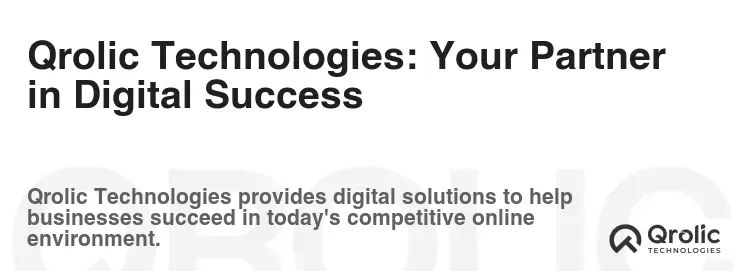
Creating a restaurant website can seem daunting, but you don’t have to do it alone. Qrolic Technologies (https://qrolic.com/) offers a wide range of digital marketing services to help restaurants thrive in the online world.
How Qrolic Technologies Can Help:
- Website Design & Development: Qrolic Technologies can create a custom-designed, mobile-friendly restaurant website that reflects your brand and meets your specific needs.
- SEO Services: Qrolic Technologies can help you optimize your website for search engines, improve your ranking in search results, and attract more potential customers.
- Local SEO: They’ll get you ranking high for the right “near me” searches.
- Online Ordering & Reservation Systems: Implement user-friendly ordering and reservation systems to streamline your operations and improve the customer experience.
- Social Media Marketing: Qrolic Technologies can help you manage your social media accounts, create engaging content, and run targeted advertising campaigns.
- Email Marketing: Qrolic Technologies can help you build your email list, create compelling email newsletters, and send targeted promotions.
- Content Marketing: Create content people actually want to read.
- PPC advertising Qrolic Technology’s experts in digital advertising will help you to run the campaigns that show great results and give you the desired outcome.
- Reputation Management: Protect your online reputation and respond to customer reviews professionally.
- Consulting and Strategy: Get expert advice on how to improve your online presence and achieve your business goals.
Partnering with Qrolic Technologies can free you up to focus on what you do best: running your restaurant. They can handle the technical aspects of website design, SEO, and digital marketing, so you can focus on creating delicious food and providing excellent service.
Conclusion: Start Building Your Restaurant’s Digital Future Today
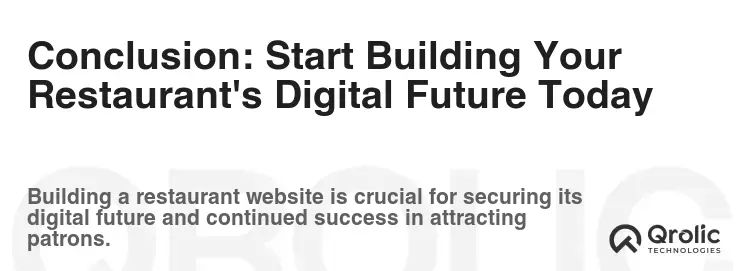
Creating a restaurant website is an investment that will pay off in increased visibility, customer loyalty, and higher revenue. By following the steps outlined in this guide, you can create a website that effectively promotes your restaurant, attracts new customers, and serves your existing customers better. Remember, your restaurant website is your digital storefront, so make sure it’s inviting, informative, and easy to use. Don’t wait any longer – start building your restaurant’s digital future today! And remember, Qrolic Technologies is here to help you every step of the way.









